7 types of emails that’ll keep people coming back for more

Your email list is an absolute goldmine, but we all know that panning for gold isn’t quick and easy. Email marketing is a long-term strategy, and the different types of emails you use matter.
As an email marketer, you need to know which types of emails to send for each situation and why. Whether you are building the subscriber relationship, asking for feedback, or going in for the sale, there are types of email marketing campaigns designed for each goal.
Let’s take a look at some of the most important types of email marketing campaigns you can use to engage subscribers, boost conversions and grow your business.
Why it’s important to send different types of emails
Whether you publish videos on YouTube, offer freelance design services, or produce artisanal gin, the goal is the same—turning subscribers into customers.
Each subscriber has different needs and emotions along the customer journey so it’s important to use different types of emails to communicate with each individual. You need to consider which types of emails correspond to each stage in your sales funnel so that you can turn intrigued subscribers into satisfied customers.
To help you get started, we’ll stick to the 7 essential types of email marketing campaigns that you should have in your arsenal.
1. Welcome emails
When I create an account or sign up to a company email list, I check for a welcome email almost immediately. This is mainly because:
I want confirmation that my account creation or subscription has been completed. To this end, welcome emails also fall under the transactional emails category
I want to check whether I am entitled to special offers or discounts as a newbie to the company
And I’m not the only one. The average open rate for these kinds of emails is 50%, with 74% of new subscribers expecting to receive a welcome email immediately.
This is your chance to make that all-important first impression!
This is your gateway into fostering a connection with new subscribers, the beginning of a hopefully beautiful (and lucrative!) brand/consumer relationship. It's your first step in moving new customers through the onboarding process.
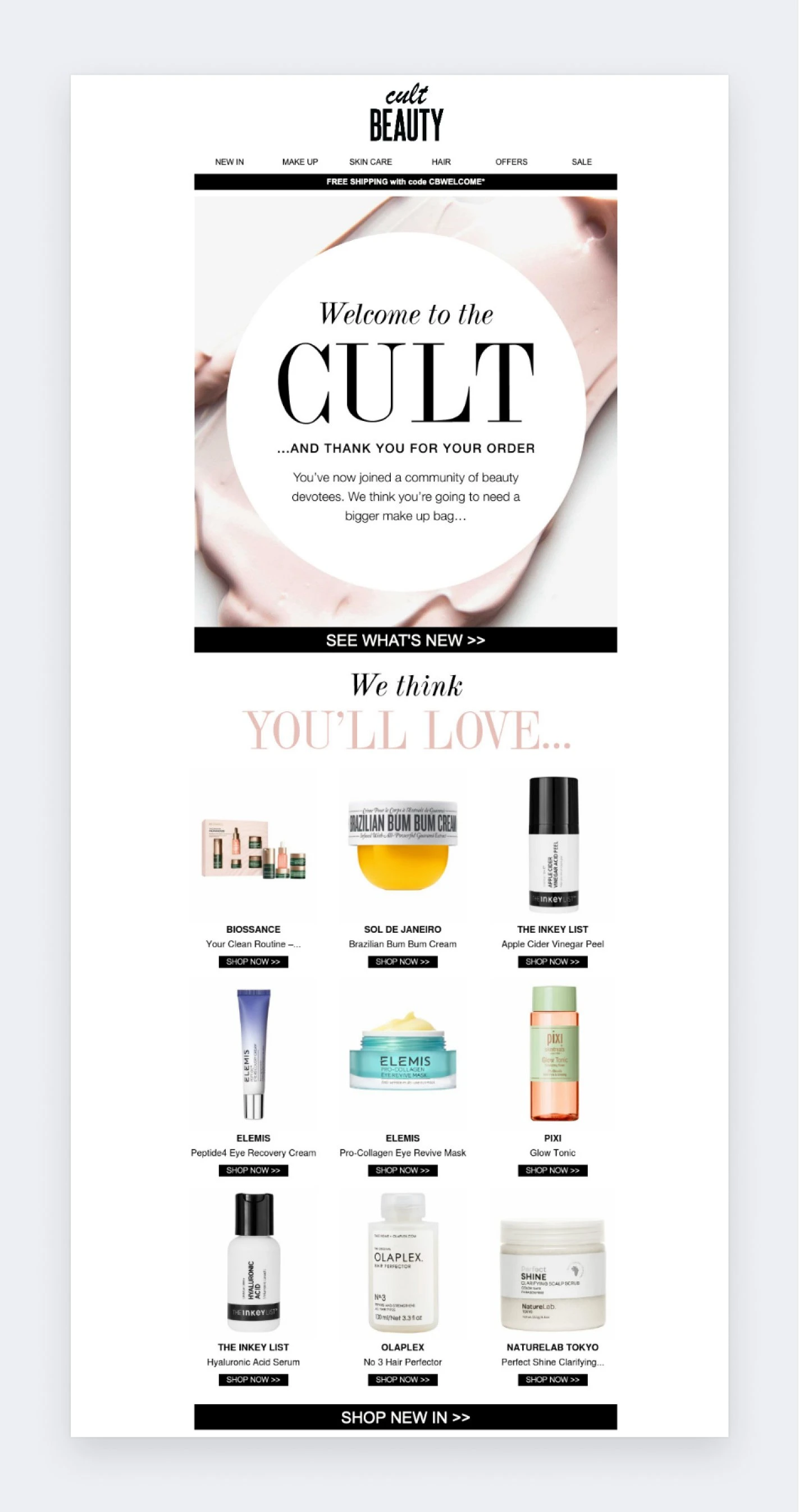
In this example from the online beauty retailer Cult Beauty, they’ve managed to hit multiple, targeted points with their welcome email. This includes:
Recommended products based on purchase history
Promotion of new products
Induction into the brand’s identity and culture with content designed to engage the user
Creating a sense of trust by encouraging contact with their customer service team
Promoting communication via social media with social buttons
At this stage, customers and subscribers are new, so they need additional steps to get started on the brand/consumer journey. Below, we see Asana offers tips to get acquainted with its features so that users can experience the benefits and hopefully convert to paying customers.
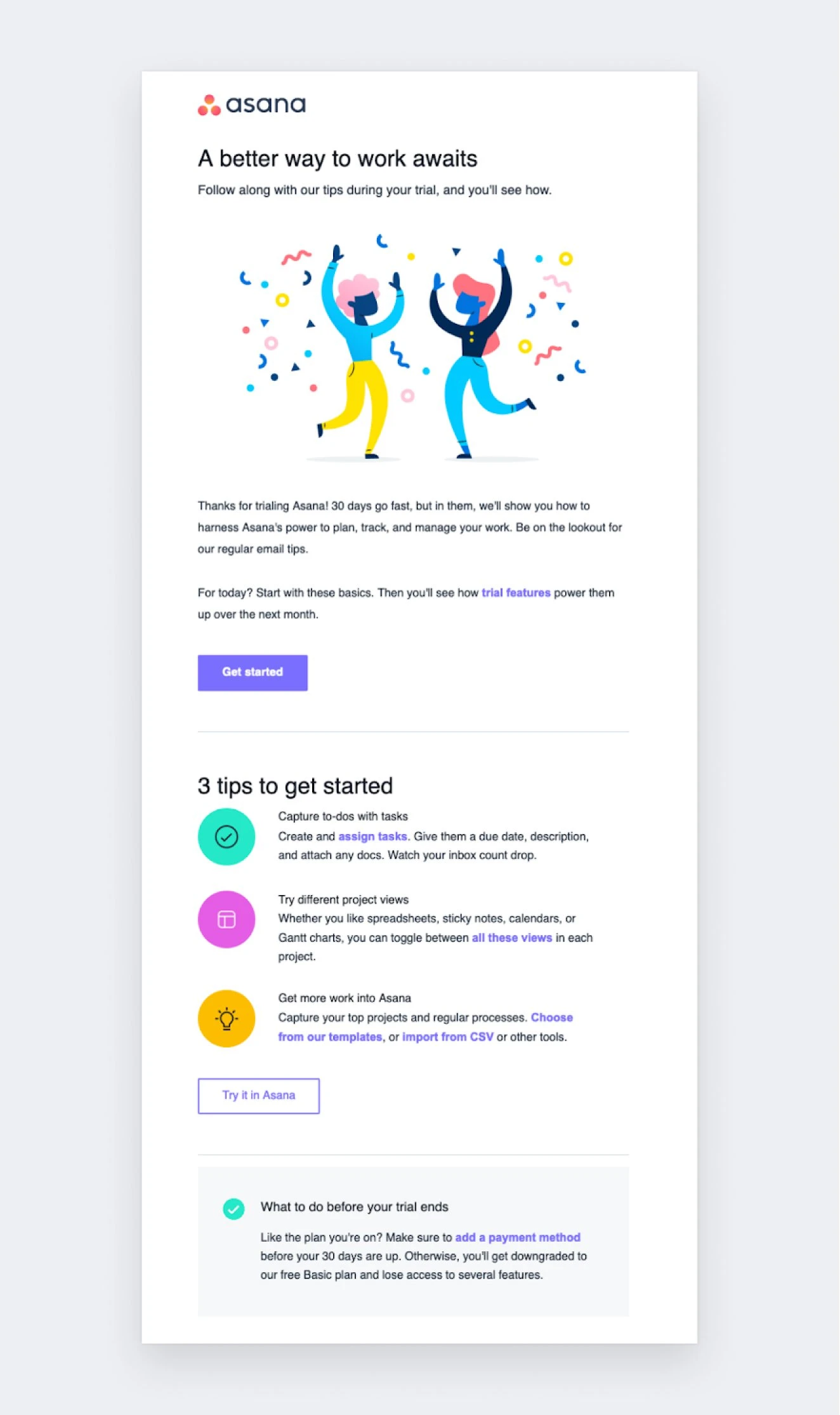
Your new subscribers should receive a welcome email within 24 hours of joining your email list, ideally straight away. You can use automation to send a single welcome email, or a series of emails sent over time that combines your welcome message with a lead nurturing email and even a special offer.
Check out this welcome email automation example and find out how to set it up in MailerLite.
2. Newsletter emails
Let’s be clear—newsletters are essential. They are used by all kinds of businesses and organizations to share valuable content and information with subscribers, customers, business partners, employees and more. These types of emails should be the bread and butter of your email marketing strategy.
With carefully considered newsletters you can keep loyal customers engaged and bring back those who have lost interest by providing value that will hopefully lead to, you guessed it, more conversions. With email newsletters you should aim to:
Increase brand awareness and cultivate relationships with your customers and subscribers
Share your latest company news, products and upcoming events
Distribute new/popular content and blog posts to increase engagement and traffic to your website
Promote the values and culture of your brand
Position yourself or your company as an authority in the industry
Increase the visibility of your business. Your competitors are landing in your audience's inbox, and you should be too!
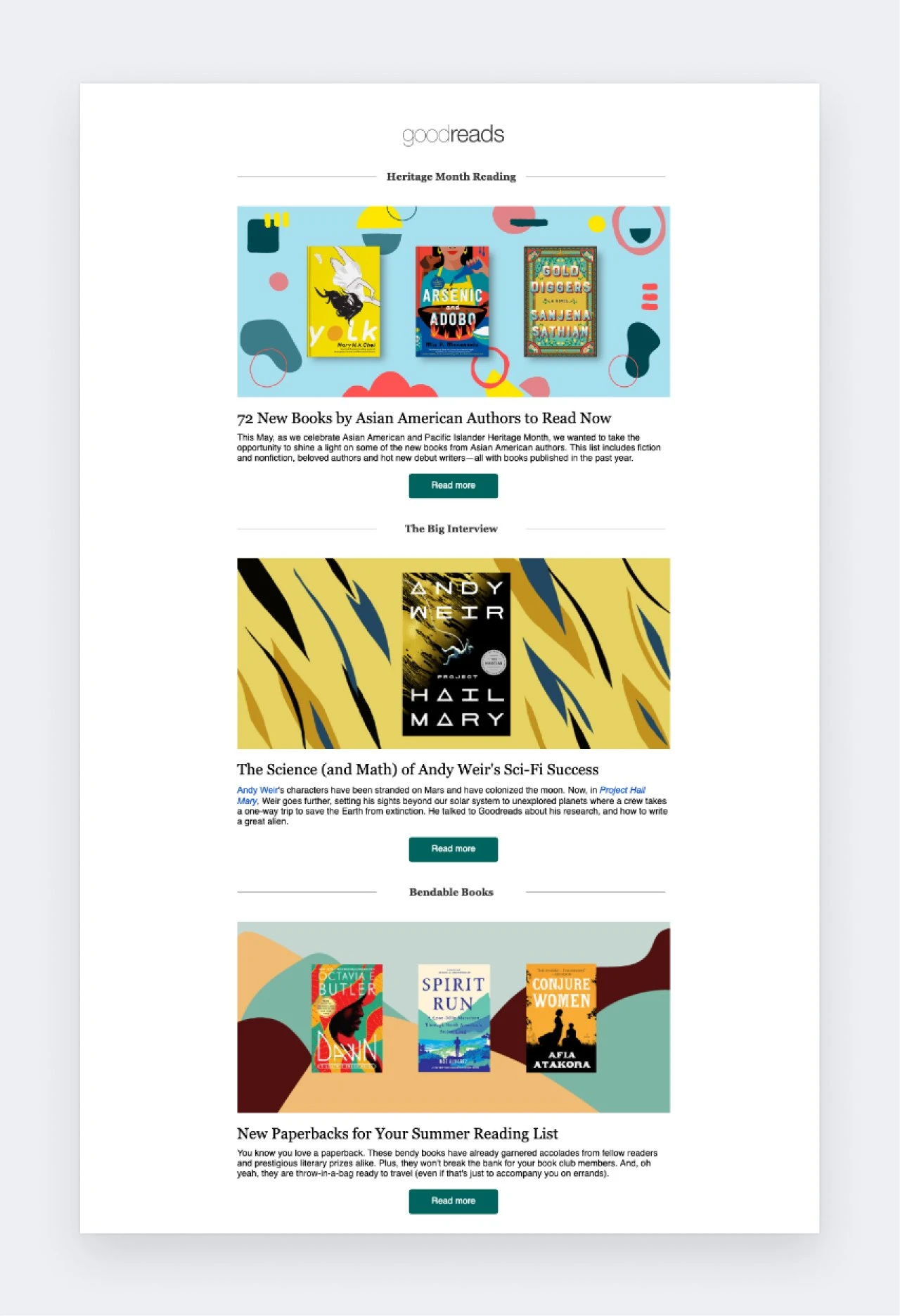
Goodreads’ newsletter design is incredibly simple but they keep me opening them up time and time again, because I know I can expect to find highly relevant, valuable content.
With this particular newsletter they:
Introduce their readers to new books that may be of interest
Give us a taste of the company values
Provide seasonally on-trend content
Prompt readers to follow Goodreads on social media and download the app.
The UX Design Institute newsletter includes on-trend, relevant content meant to inspire the reader.
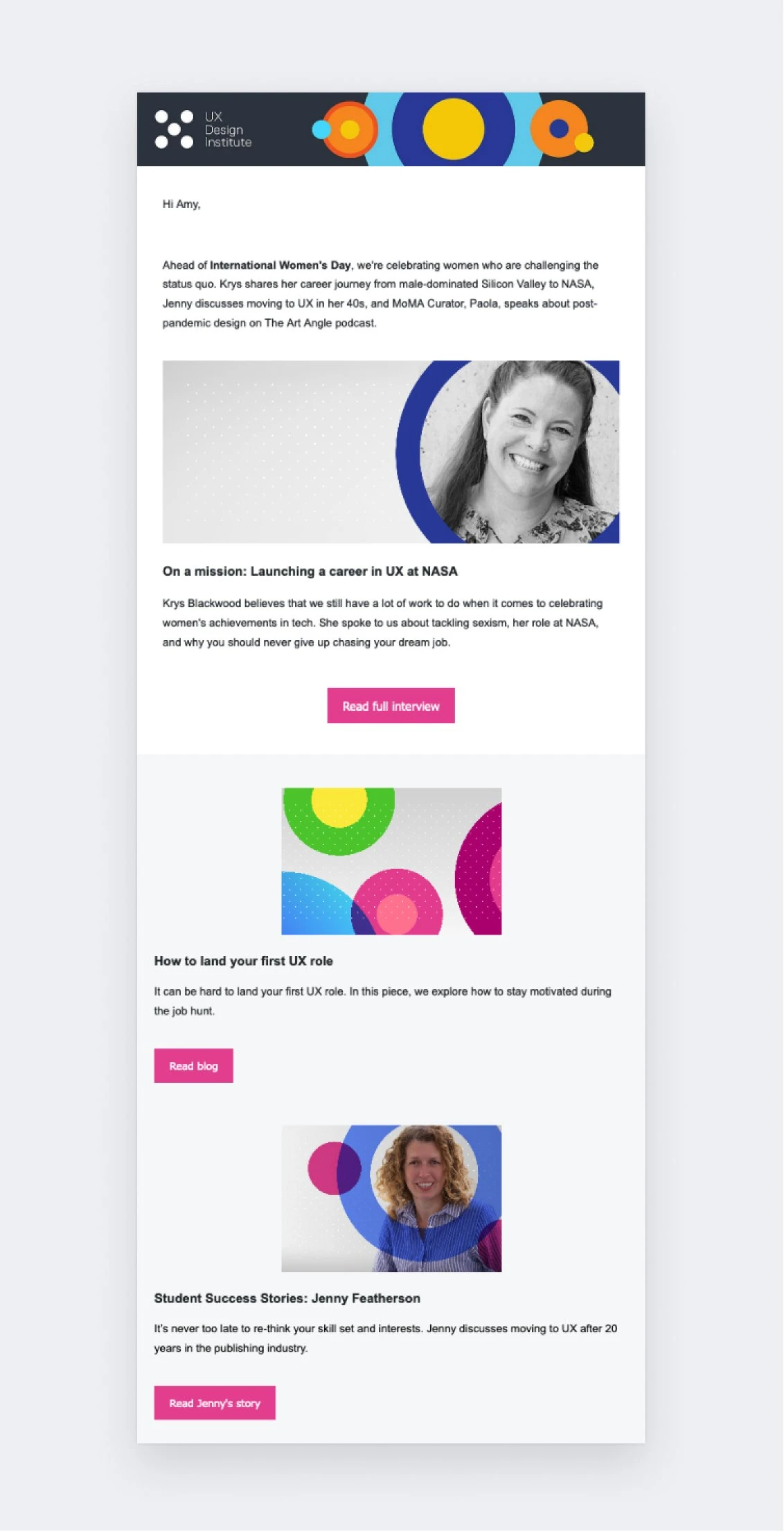
You can start sending your newsletters right away. Just remember to set expectations with subscribers on how often they will receive it. Check out this article on email cadence for best practices.
3. Lead nurturing emails
Sure, some customers will commit when they're ready, regardless of your communication. But to maximize conversions you need to nurture them, and the numbers back that up. Studies suggest that nurtured leads make purchases that are an incredible 47% larger than unnurtured ones.
To do lead nurturing right, you need to strike the right balance in terms of frequency and content to gently remind your email list of your products or services, and encourage them to take the next step in the buying process. Your lead nurturing emails should aim to:
Increase visibility and communicate with readers on a regular basis
Consider the reader’s interests and suggest relevant products, services or content
Address the reader’s problems and offer a solution, outlining the benefits
The ultimate goal is to guide leads through the sales funnel.
So you need to provide valuable content, offers and solutions that will encourage them to take the next step.
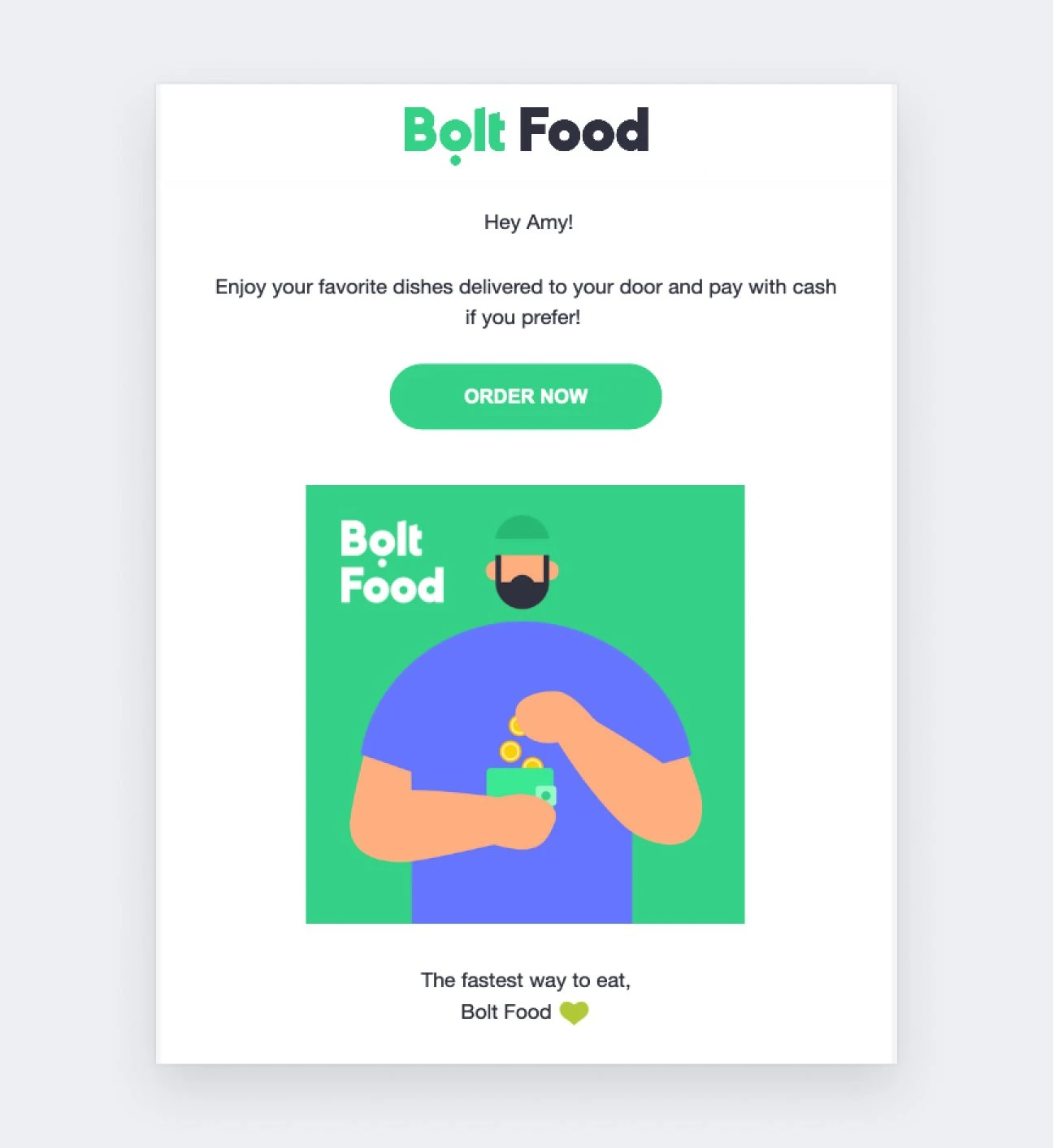
I love this e-commerce example from Bolt Food because it’s so simple and yet so effective in targeting customers from a particular group of leads. Bolt addresses a single pain point: the payment method, and encourages the reader to take a specific action.
This example from Adobe demonstrates a longer sales funnel strategy. They provide valuable content in the form of tips and tutorials to make the reader fall in love with the brand.
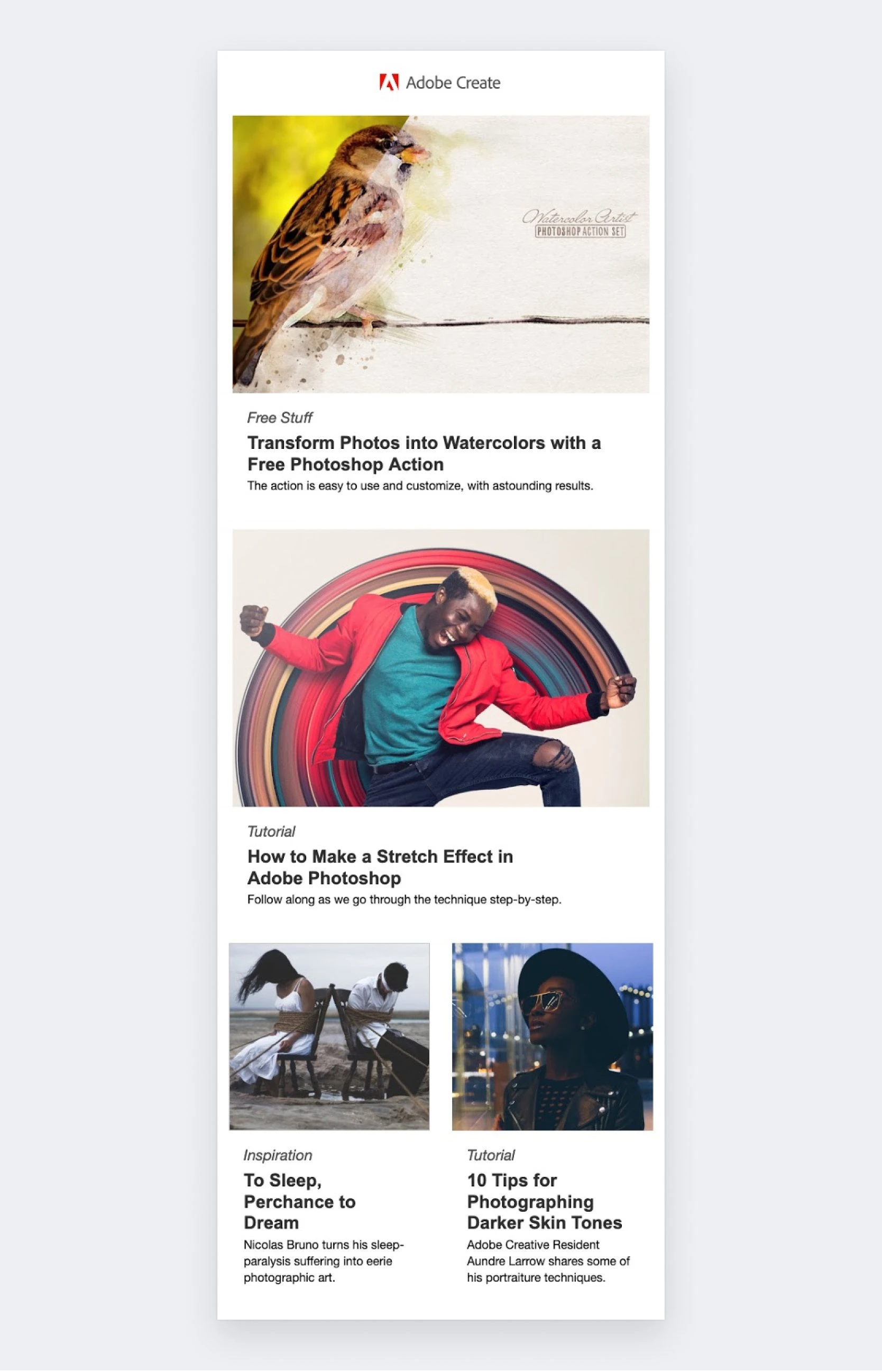
Not every lead nurturing attempt will convince every customer to act. But if you continue to add value with every newsletter, you can gradually turn your goldmine of subscribers into shiny nuggets of success!
Lead nurturing emails should be sent throughout all levels of the sales funnel with the goal of strengthening subscriber relationships. Think about what you’re trying to achieve at each stage, and which kind of content will get the job done.
4. New product / service emails
Are you introducing a new line of scented candles to your collection? Perhaps you're expanding your freelance writing business to include website audits. Whatever the new product or service is, the first people that should know about it are your existing customers.
After all, these are the buyers that have tried and tested your offering, and have stuck around to hear more!
You can use these types of emails to:
Inform existing and potential customers about products or services
Offer exclusive content by giving a sneak peek before anything goes live on your website
Make feedback requests before the official launch
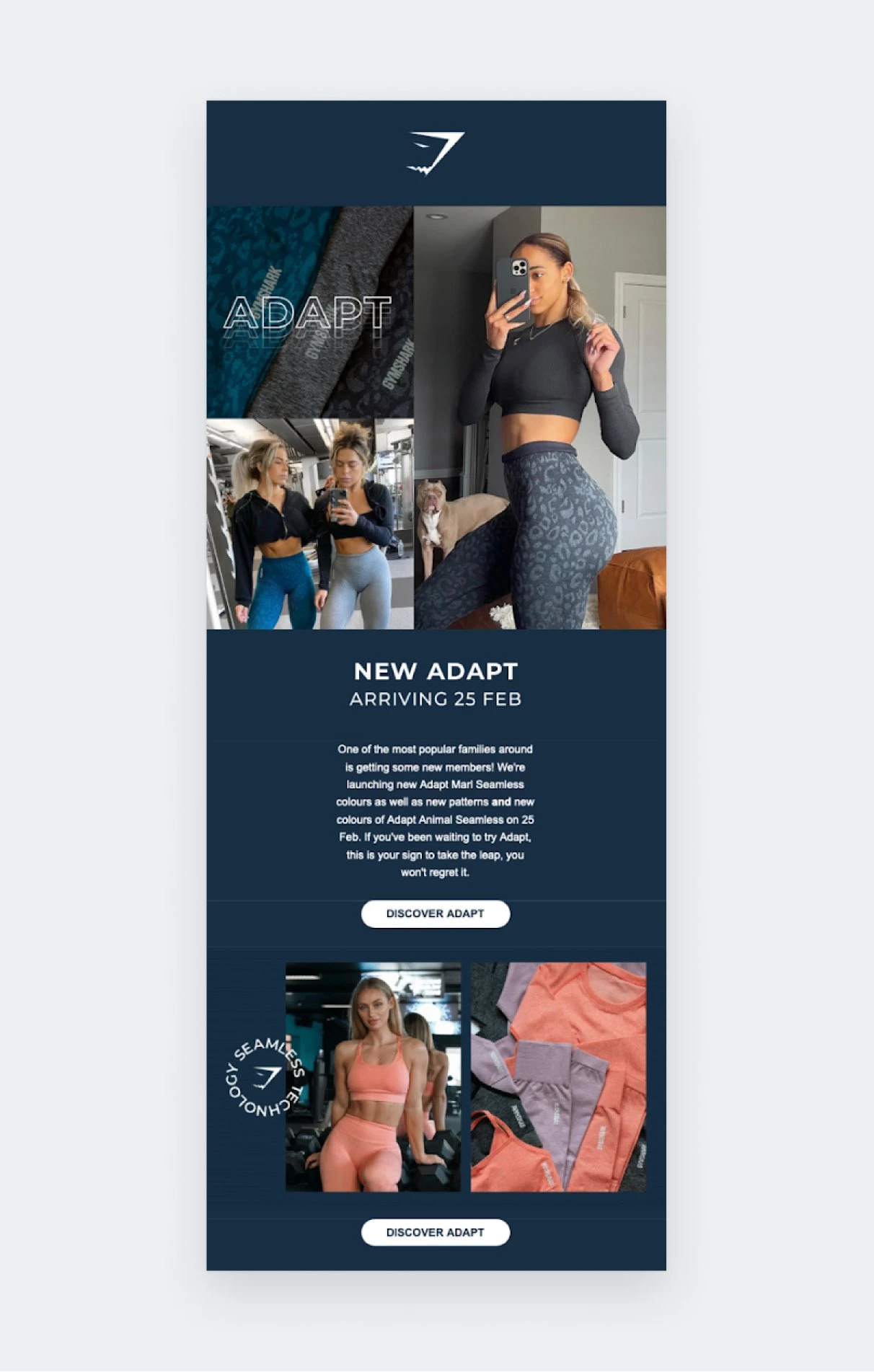
Gymshark manages to create so much buzz around their product releases, that new lines are often sold out within minutes.
For a more interactive experience, countdown timers are great for building excitement and anticipation around your launches.
In another example, Netflix keeps users engaged with regular updates on new titles.
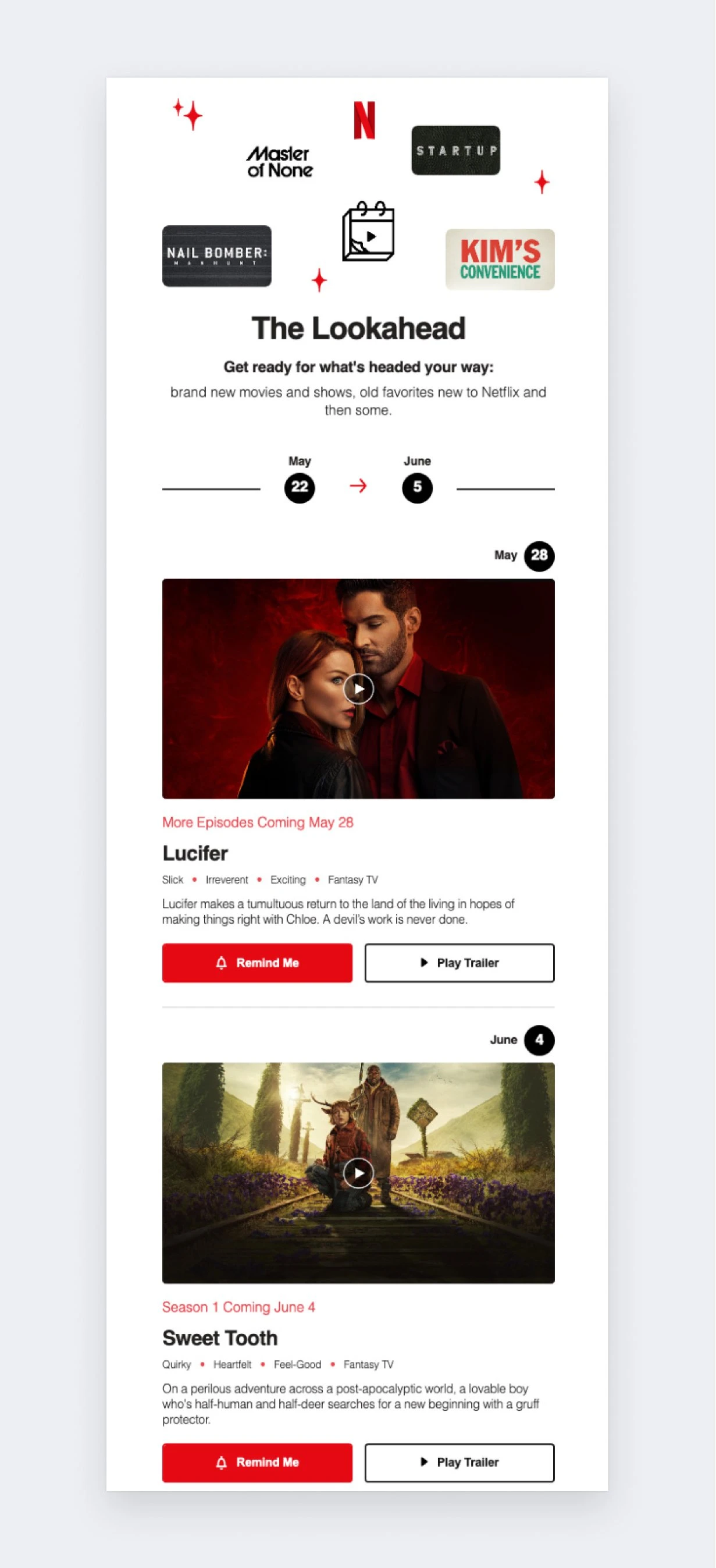
The best time to send this type of email is when there is something new to share with subscribers. If you want to promote a product or service, make sure it is relevant or newsworthy.
5. Special offer emails
Special offer emails are a great way to encourage buyers on the fence and repeat customers to take the plunge and make a purchase. Believe me, I know. My wallet can vouch for this. 😅
Whether you're offering a discount, a free trial, free shipping or some other gift, the prospect of a good deal is hard to resist. Creating exclusive offers for your email subscribers makes it even harder to pass up.
When crafting these types of emails, you need to keep all important information clear, concise and easy to digest. As with this offer from asos, everything I need to know is clearly visible.
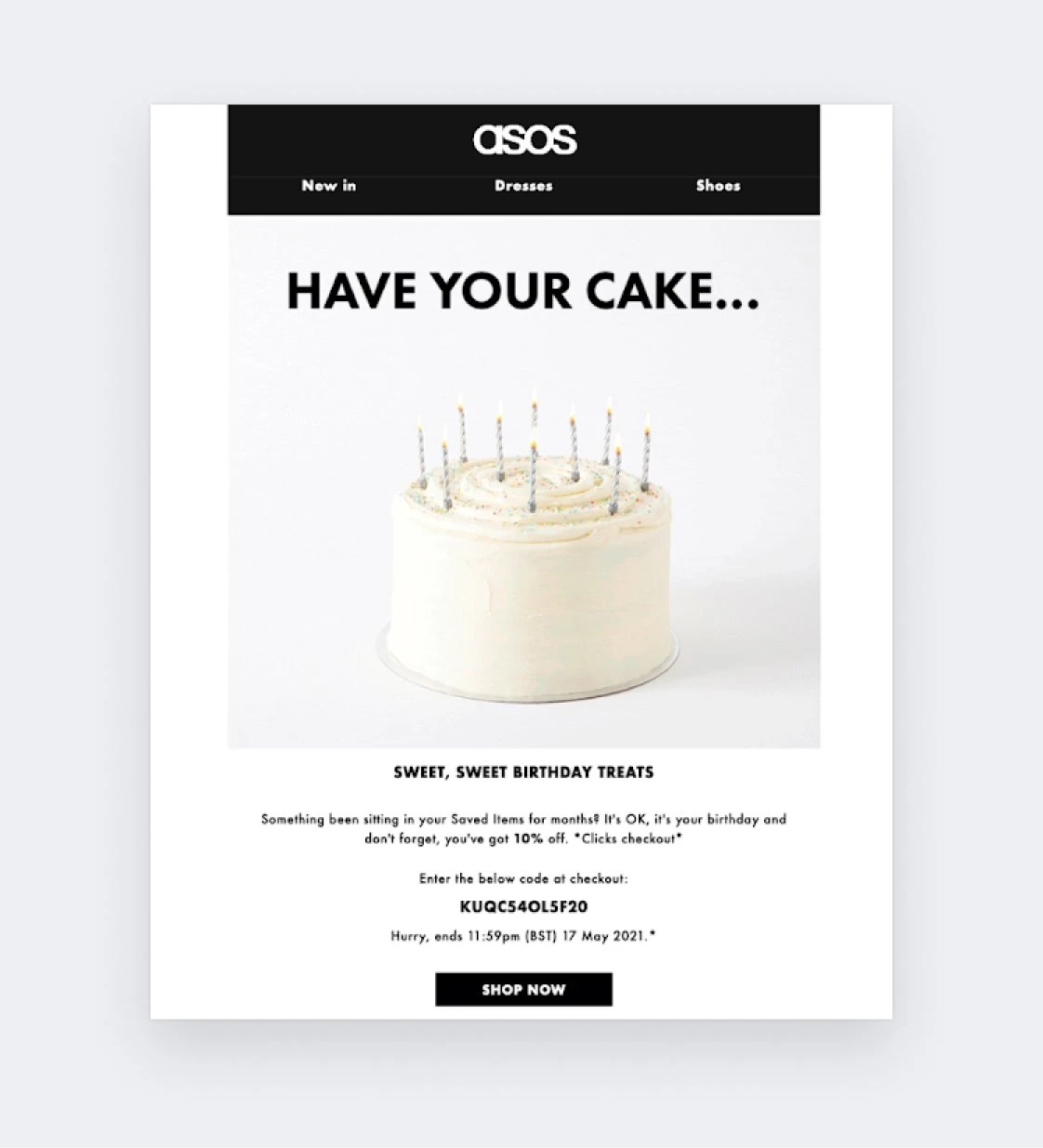
How sweet! A special birthday offer just for me!
Sarcasm aside (sorry not sorry, I’m a Brit!), these kinds of emails are a great way to bring back customers, but when you take the extra step of personalization, you show appreciation and gratitude. It feels great when a brand that you care about, cares right back.
Below, Bestsecret goes short but sweet with a simple free shipping offer.
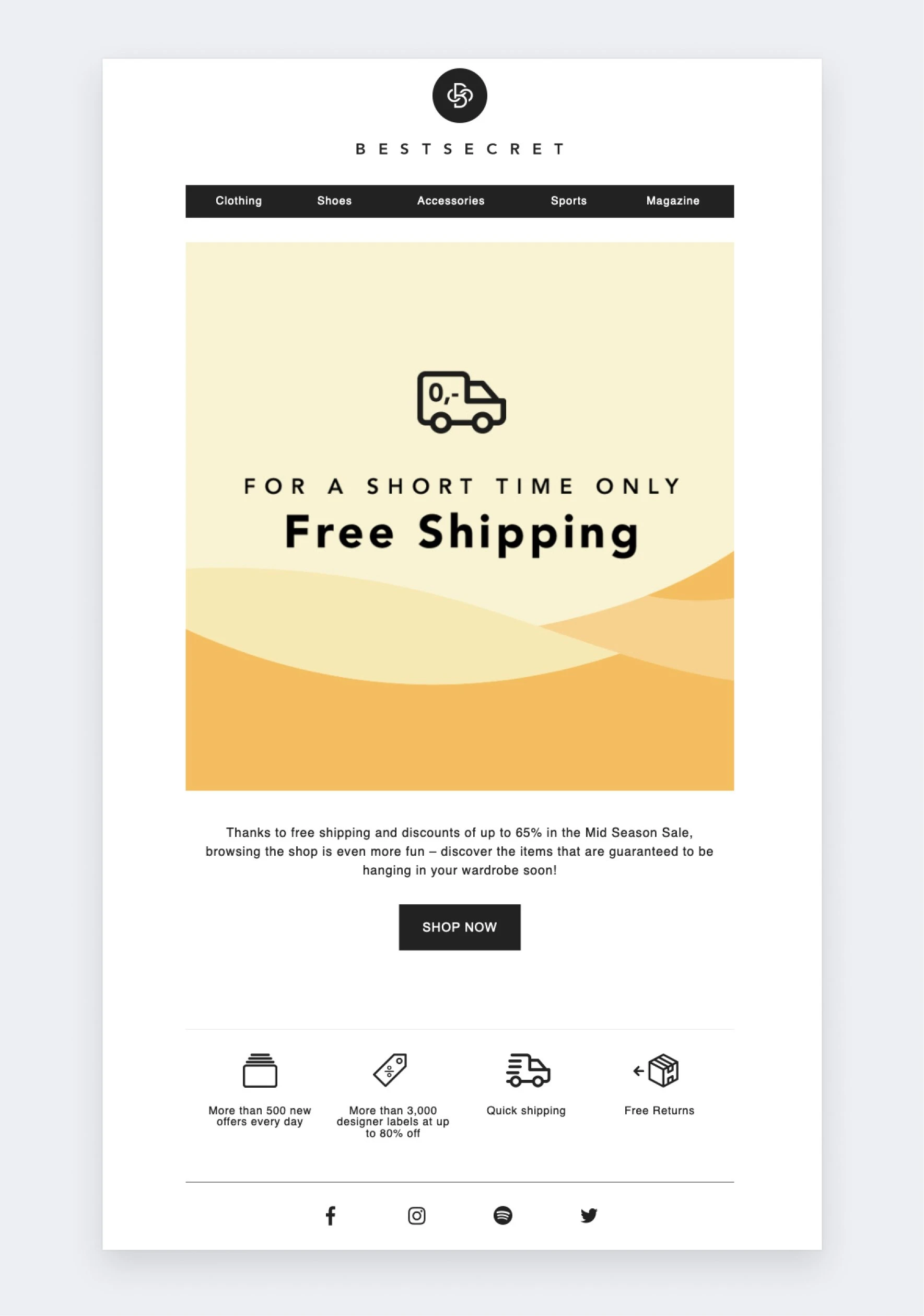
Promoting special offers is a great way to engage subscribers at all stages of the funnel. Just don’t overdo it. When you send too many ‘special offers’, they cease to be ‘special’ and turn into ‘annoying’. You get it.
6. Review request emails
The Internet has blessed us with the ability to research and find information and opinions about basically everything (just Google hilarious Amazon reviews). Although it's great for consumers, companies need to have a strategy in place to stay ahead of the game.
Bad reviews = bad news, no reviews = also bad news. According to TrustPilot, 9 out of 10 consumers check online reviews before committing to buying. Clearly your online review strategy needs to be at the top of your priorities.
Your subscribers are your biggest fans.
They are your best source of outside knowledge and unbiased opinions about your products, services and brand. And not only is review gathering valuable in terms of building your online presence and trust, but it also gives you priceless insights into what you’re doing right and where you can improve.
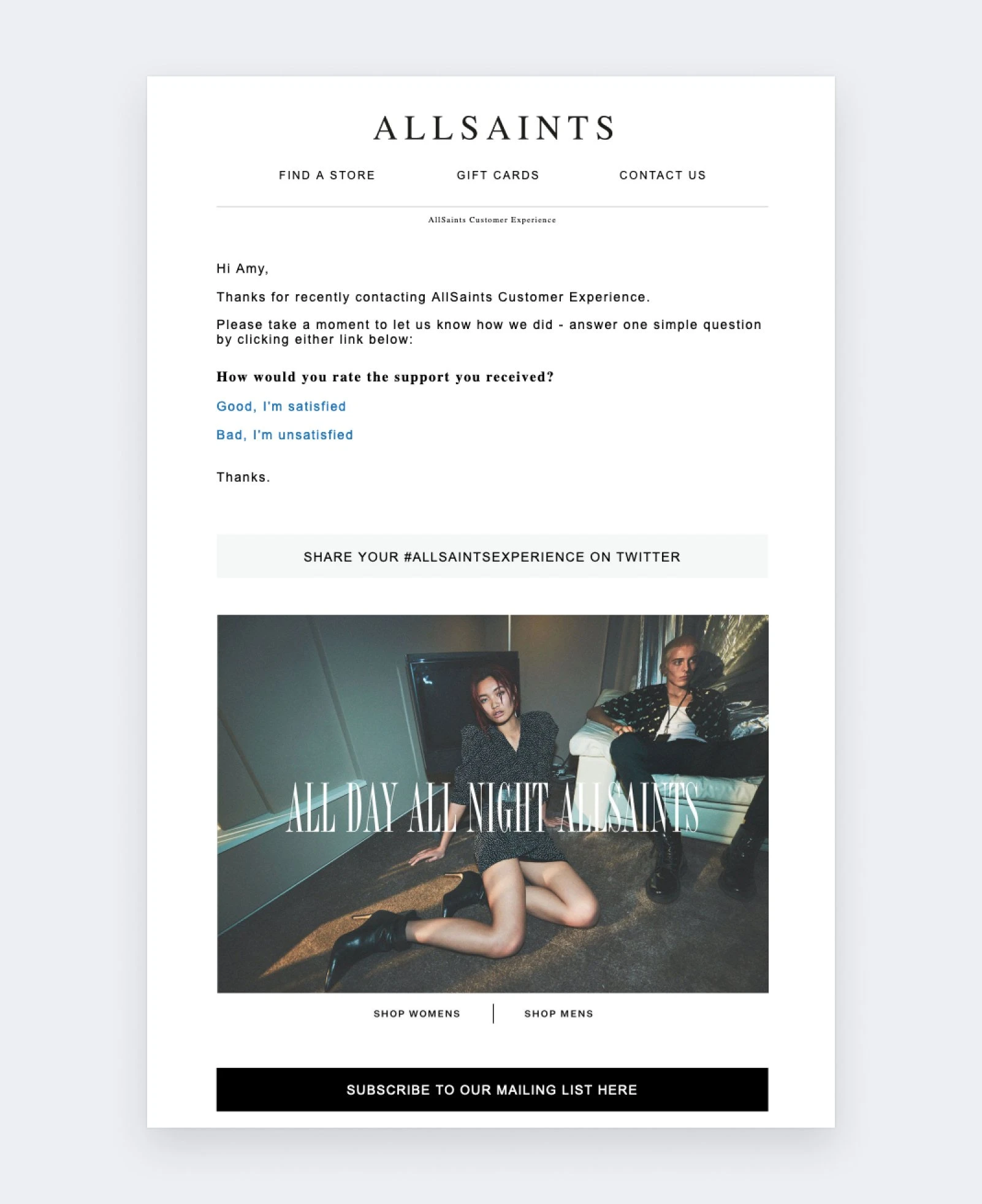
Allsaints makes it quick and easy for customers to leave feedback, with a simple positive /negative button selection. Users can then provide additional information. Even better, after submitting feedback, they offered a €20 voucher as a reward!
SpaceNK’s review request is fun and engaging and throws in an incentive too!
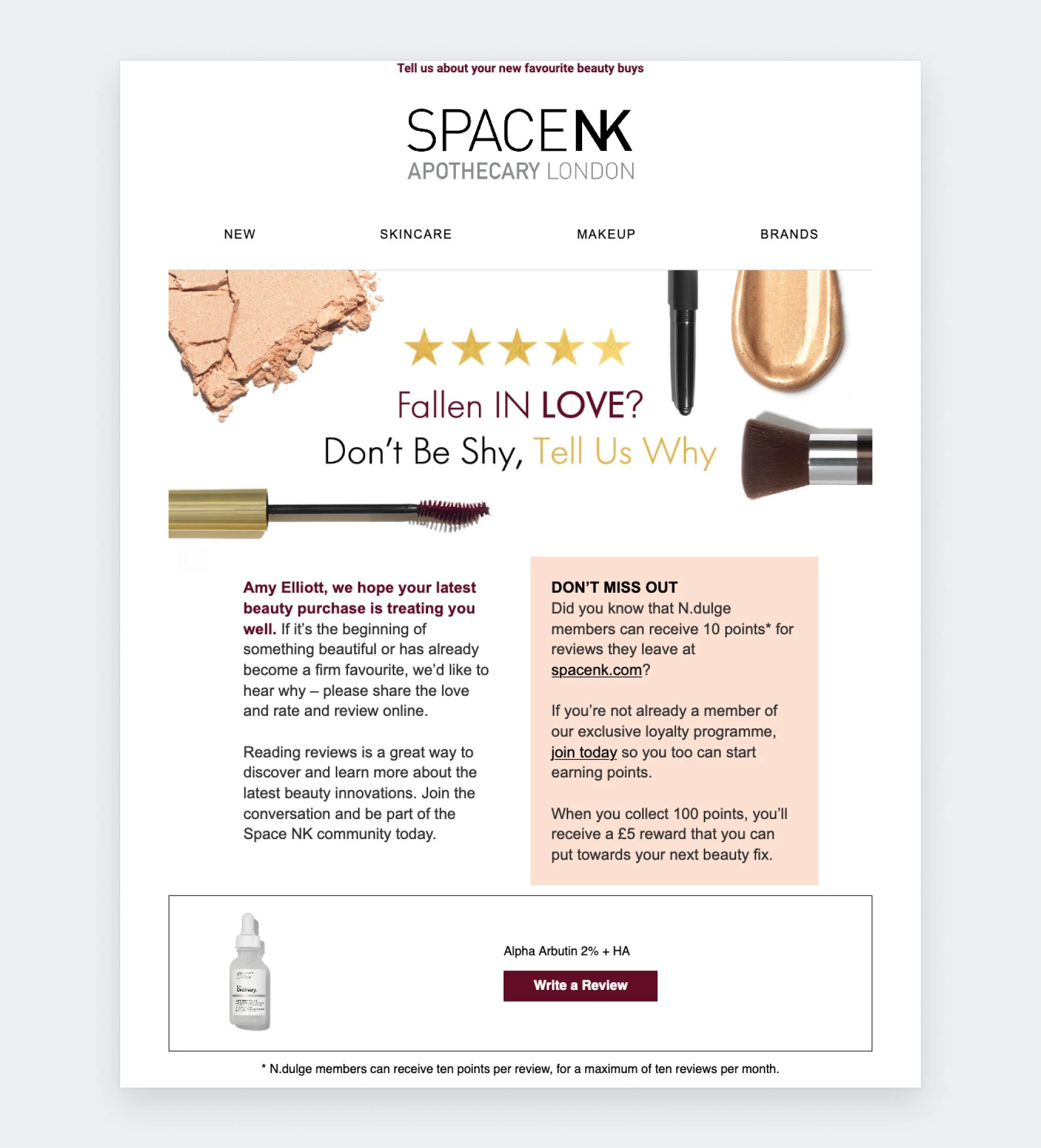
Providing an incentive encourages customers to take the time to submit reviews and if your service is already top notch, they are happy to do so.
These are reserved for subscribers who have fully experienced your products or services. The best time to send is soon after they’ve made a purchase. You can create an automation sequence that automatically sends a review request after a specific period of time has passed after a subscriber’s purchase.
7. Survey Emails
Listening to feedback about products and services is all par for the course when you want to provide excellent customer service. To take the experience up a level, you need to consider your brand as an experience and collect feedback across all aspects.
The best way to do this is through your email list. With regular survey emails you’ll gain valuable, actionable insight into your service and content and reinforce the consumer/brand relationship. It tells your customers that their opinions and experiences matter. Plus you’ll get bonus points if you regularly respond and implement changes based on their feedback.
When creating these types of email campaigns, it’s important to remember that time is valuable. Your subscriber’s probably don’t want to spend more than a couple of minutes and a few clicks on answering your survey. Make it as simple, clear and focused and, if possible, let them know how long it will take.
An embedded survey is a great way to get subscribers engaged, as they allow questions to be viewed directly in the email. They offer a more seamless experience in which the subscriber can answer the first question and then complete the survey in the browser without any interruption!
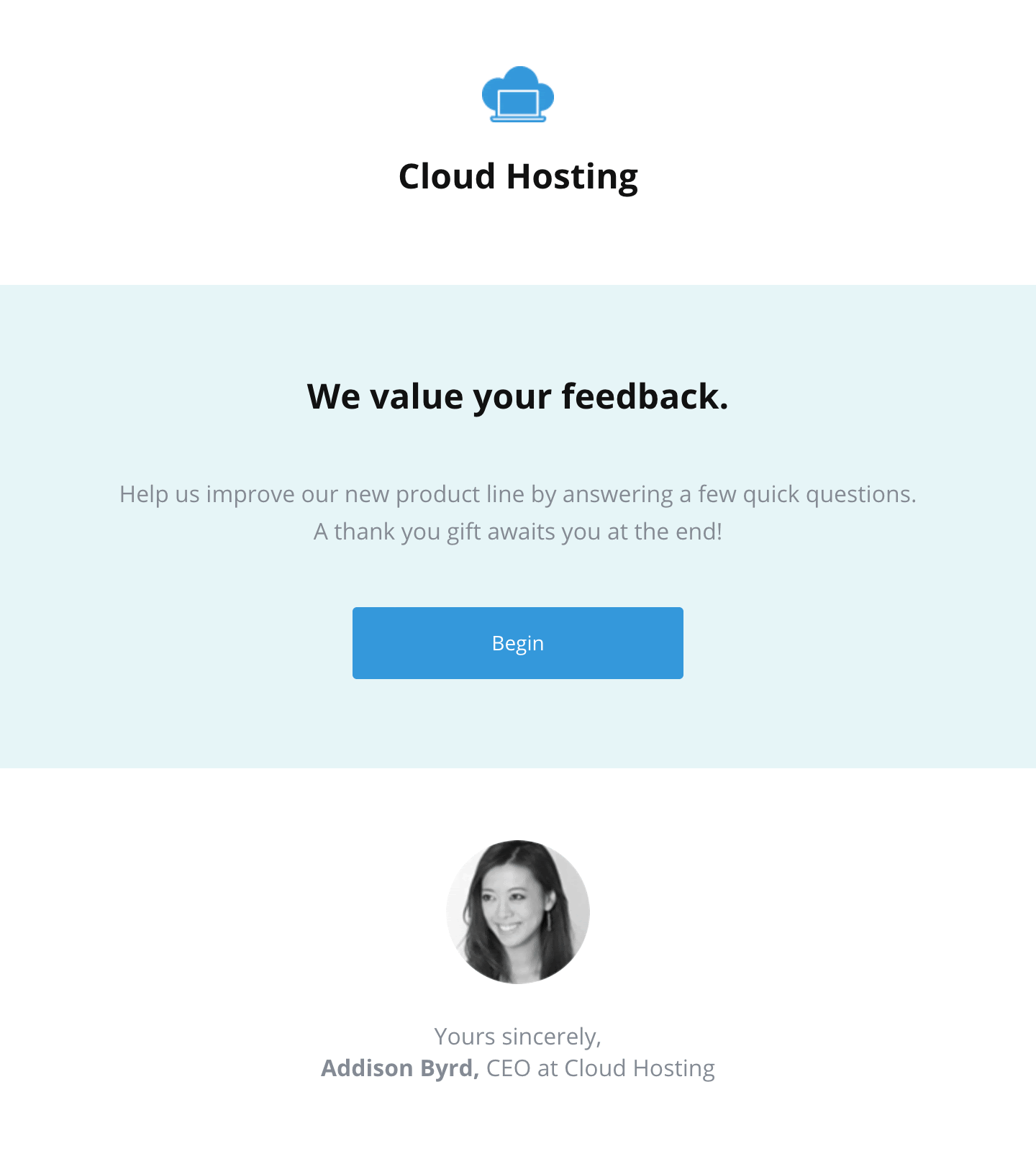
If your survey is teetering on the longer side, try to give an incentive to reward your subscribers for their participation. They’ll love you for it!
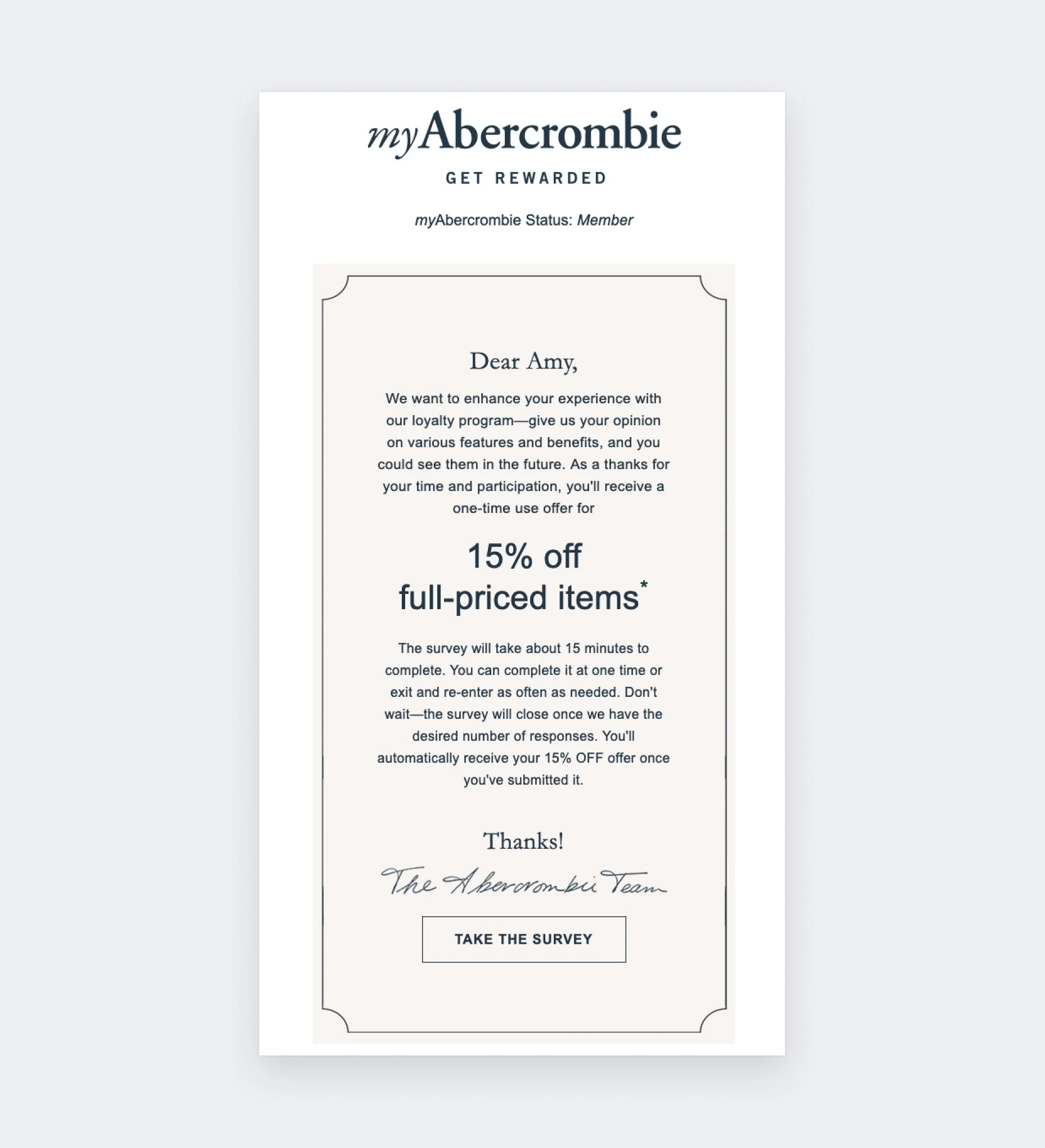
In this example from Abercrombie, not only has their language made me feel like they care about my experience, they’ve also given me another reason to head back to their shop and place an order. It’s a great way to gather the feedback you need, make your customers happy and register another conversion!
There are no strict guidelines when it comes to sending survey emails. Although some studies have shown that weekdays, particularly Mondays and Thursdays, are the best days to send survey invitations; with the best time to send your survey email being off-peak workday hours.
You can then use automation to follow up after with your survey recipients. Check out the net promoter score survey email automation example.
Final takeaway
Avoid one-dimensional email marketing! By using a variety of email types to achieve your objectives, you’ll engage subscribers at every stage of your customer funnel. To increase conversions and maintain strong relationships with your subscribers, always consider the what, the why, and the when.
Hitting that sweet spot between the subscriber’s needs and your email content is a foolproof way to provide value that leads to happy and loyal customers.
Jump in on the comments! Let us know your favorite types of emails.
